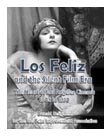Recommended
Reading
"Los Feliz
in the Silent Film Era: The Heart of Los Angeles Cinema 1908 to
1930"
by Donald Selligman (Los Feliz Improvement Association,
2013)
A review by Steven Suttle
At first blush, one might think that a book published by
a neighborhood association would be little more than a later version
of a "map to the stars' homes." In the case of "Los
Feliz in the Silent Film Era," you'd be wrong. This is a
full-sized, hardback volume worthy of inclusion in any silent
film or film history library. The work is extremely well-organized
and thoroughly researched. It is informative, and the alphabetical
layout includes, in most cases, a single page devoted to an individual
actor, director, producer, or screenwriter. The reader is given
a map, a photograph of the subject, a movie poster, and a photo
of the house or apartment building (if still standing) in which
he or she lived. The author, Donald Seligman, also  provides
relevant biographical information that is particularly helpful
in the case of lesser-known personalities. Throughout the book
the reader will find well-researched montages of still photographs
related to a performer or to a silent film genre. The posters
and stills prove to be a delightful treat as they add a dash of
color and also help place the subjects in their career contexts.
These touches enhance what could have been a mundane recitation
of names, addresses and dates.
provides
relevant biographical information that is particularly helpful
in the case of lesser-known personalities. Throughout the book
the reader will find well-researched montages of still photographs
related to a performer or to a silent film genre. The posters
and stills prove to be a delightful treat as they add a dash of
color and also help place the subjects in their career contexts.
These touches enhance what could have been a mundane recitation
of names, addresses and dates.
Seligman relies on census data from 1920 and 1930 plus draft
registration records from World War I to pinpoint exact residences.
A surprising number of the movie colony rented rather than owned
these properties, so land title records would have been of little
value. Everyone from the very famous - Bebe Daniels, Cecile B.
de Mille, Louis B. Mayer, Frances Marion, Walt Disney, Norma Talmadge
- to the relatively obscure, but nonetheless interesting - Edward
Hearn, Maxine Elliott Hicks, John Cossar - are included. Significantly,
the book's photos of extant homes are accompanied by current addresses,
so if you do visit this mostly charming and historic neighborhood,
you can actually see where Charlie Chaplin lived in 1918. Even
without this exhaustive history, Los Feliz is an interesting visit
with its wonderful mix of craftsman homes, elegant apartment buildings
and wonderful Moorish mansions. It is well worth a look on any
trip to Los Angeles.
There is a brief history of the development of film followed
by a chronology of Los Angeles from the original Los Veliz (sic)
Land Grant through the early days of filmmaking in and around
Hollywood and Edendale. This section also contains maps showing
the locations of the first southern California studios. Sadly,
only three remain. The rest having long ago succumbed to developers'
bulldozers. All of this makes for interesting reading and demonstrates
Seligman's serious interest in the history of the area.
This is an enjoyable read. It is handsomely presented, remarkably
detailed and extremely informative. I highly recommend it.
Los Feliz in the Silent Film Era: The Heart of Los Angeles
Cinema 1908 to 1930 is available from the LFIA for $38.15
including tax. Checks should be sent to the "LFIA Treasurer"
at P.O. Box 29395, Los Angeles, CA 90027.
Purchase
this book from
 Just click
on the link above and type in the author's name
or the book
title in Amazon's search field.
Just click
on the link above and type in the author's name
or the book
title in Amazon's search field.
Return to "Recommended
Reading" page
 provides
relevant biographical information that is particularly helpful
in the case of lesser-known personalities. Throughout the book
the reader will find well-researched montages of still photographs
related to a performer or to a silent film genre. The posters
and stills prove to be a delightful treat as they add a dash of
color and also help place the subjects in their career contexts.
These touches enhance what could have been a mundane recitation
of names, addresses and dates.
provides
relevant biographical information that is particularly helpful
in the case of lesser-known personalities. Throughout the book
the reader will find well-researched montages of still photographs
related to a performer or to a silent film genre. The posters
and stills prove to be a delightful treat as they add a dash of
color and also help place the subjects in their career contexts.
These touches enhance what could have been a mundane recitation
of names, addresses and dates.